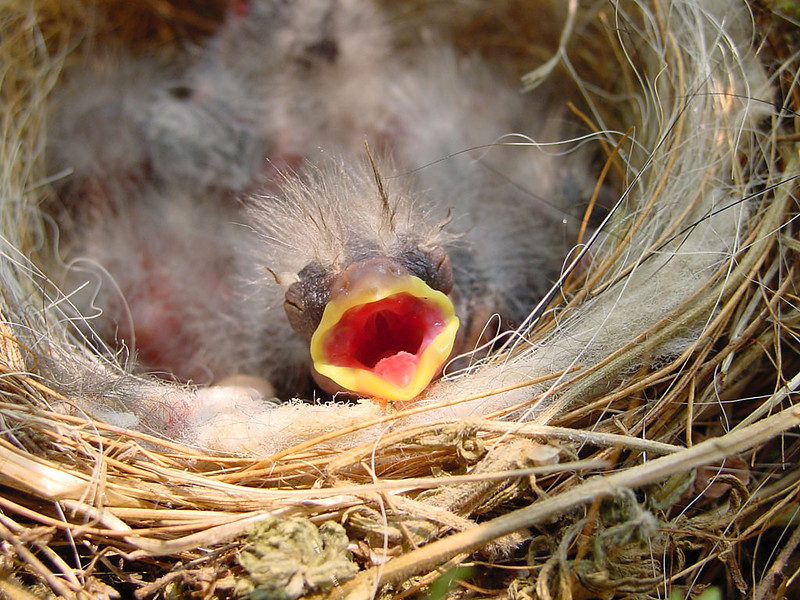After hatching in spring, baby birds sometimes end up on the ground, but that doesn’t necessarily mean they need help.
It depends on how old they are, how long they’ve been on the ground and whether they are injured, said Dana Sanchez, Oregon State University Extension Service wildlife specialist. Identifying the age of a bird is crucial in how you deal with one. The youngest are newly hatched fledglings and should not be without their parents. Older nestlings, on the other hand, are better-equipped to spend time out of the nest.
Nestlings can be identified by their feathers – or lack of them, Sanchez said. If feathers are apparent, they’ll be tiny, still-encased “pin feathers” often not discernible or just little tufts with naked skin showing. Because they often can’t hop yet, nestlings drag themselves around by their wings and look like they are injured. Fledglings, which are a few weeks old, look more like young birds covered with down and feathers.
If you witness a bird being attacked by an animal, no matter if it is a nestling or a fledgling, don’t touch it and call a wildlife rehabilitation center. Find one in your area at the Oregon Department of Fish and Wildlife website. Never try to raise a baby bird, injured or not, Sanchez stressed. No matter how much you think you’re helping, removing or capturing wildlife and keeping it is against the law unless you’re a trained and licensed wildlife rehabilitator.
Nestlings are too young to be by themselves and should be in the nest with their mother. If you come across a nestling on the ground, look for the nest and put the bird back into it. If you can’t find the nest or it’s too high, put the baby bird in a container with small drainage holes like a berry basket lined with straw or a bit of soft fabric. Place it on a branch as high as you can reach in a sheltered spot not in direct sun. Watch to see if adults find them. If the parents don’t return or the baby ends up on the ground again, it’s time to call a rehab center.
“It’s alright to touch a baby in order to put it in a nest,” Sanchez said. “Birds don’t have a good sense of smell so parents will be OK with it.”
Fledglings are at a stage in life when they are ready to leave the nest on their own and can spend almost a week on the ground before they’re ready to fly. They will often try to stay close to cover under shrubs or trees. Leave them where they are and keep people and pets away. The parents track them and will likely provide some food.
“Watch from a distance,” Sanchez said. “Don’t touch fledglings. You don’t want to interrupt the cycle of parents feeding them.”
It’s important to recognize the difference between a fledgling and an injured adult. Fledglings have feathers, but shorter and different colors than adults. Tail feathers will be short and wing feathers will be stubby. Initial feathers are often made to camouflage the bird so they’ll be less obvious to predators.
If you see ducks and geese, don’t approach. Ducklings and gooselings are able to walk and eat as soon as they hatch, but learn how to get to water and avoid predators by staying with the clutch. Babies crossing the road behind mom can become separated if a vehicle goes past or a well-intentioned person tries to catch them. If you see this, you can call a wildlife rehabilitation center.
Owlets are among the first birds to hatch and move about on branches before they can fly. If one takes a wrong step or get blown off a branch and ends up on the ground, put it on the highest branch you can reach and they’ll be able to make their way back up. Be careful, though. Owlets have sharp talons.
Kildeer are notorious for nesting in parking lots and other gravel and wood-chipped areas, Sanchez said, so be on the lookout and find ways to mark off and reduce human and pet disruption near the nest. The eggs hatch in 24 to 28 days, so try to protect for those couple of weeks. The young walk around and feed right after hatching and have a high-pitched voice that sounds like they are in distress, but they are not. If anything, they are calling their parents for food.
-30-
About OSU Extension: The Oregon State University Extension Service shares research-based knowledge with people and communities in Oregon’s 36 counties and the Confederated Tribes of Warm Springs. OSU Extension addresses issues that matter to urban and rural Oregonians. OSU Extension’s partnerships and programs contribute to a healthy, prosperous and sustainable future for Oregon.

